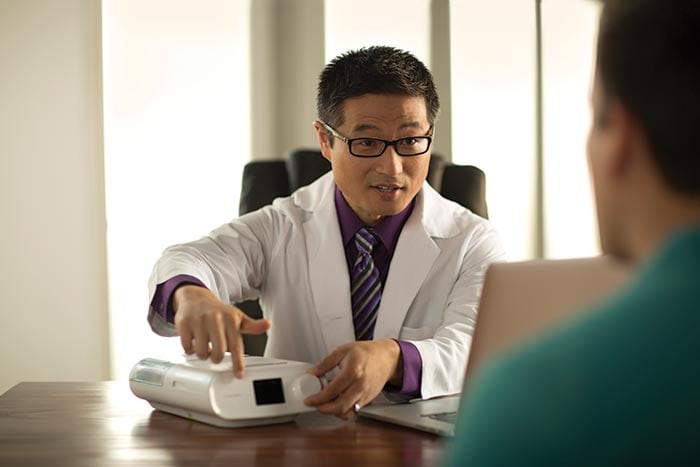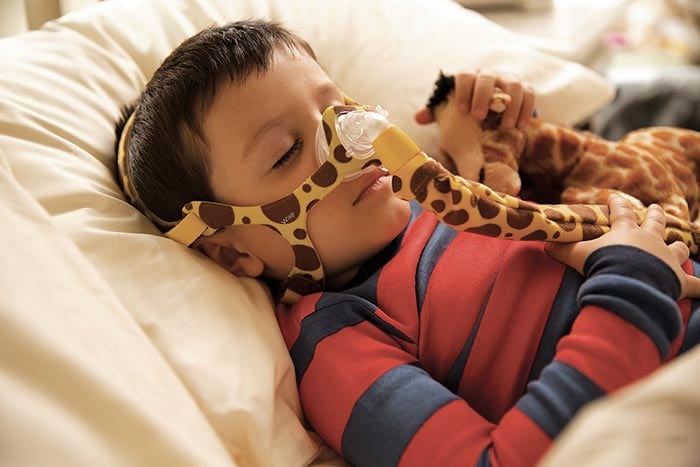July/August 2016

Moving the needle on patient adherence
Among clinicians, patient adherence to prescribed therapy remains a pervasive healthcare obstacle.1 In fact, about half of all sleep therapy patients are non-compliant to their treatment after only one year,2 adding to patients’ sleep woes and a long road of residual health issues and medical expenses. Establishing positive behaviors early in treatment has proven key to combating poor adherence,2 and clinicians, now armed with remote-monitoring technology, can keep patients accountable and treatment on track. Bill Hardy, a Senior Clinical Researcher and Developer with Philips Respironics, sat down with us to talk about how informatics is being applied today.
What technology trends are you seeing or working on today in terms of establishing and managing good adherence behaviors?
Hardy: It’s all about the ability to capture and track adherence or use in real time by connecting monitoring software with the device itself. Philips does this through its newly released cloud-based technology, Patient Adherence Management Service (PAMS), which is currently available in the US only. The technology allows for personalized calls, emails and texts to the patient through internet-connected devices. PAMS can educate the patient on the importance of sleep therapy, and deliver motivational reminders and support from sleep coaches and respiratory therapists trained in health behavior change. The technology also allows homecare providers to read engagement metrics, identify patients struggling with therapy adoption, and intervene as needed. Finally, patients can also track their own data through a mobile application
What is the future of patient informatics?
2. Weaver T et al. "Adherence to continuous positive airway pressure therapy: the challenge to effective treatment." Proceedings of the American Thoracic Society 5.2 (2008): 173-178.
Hardy: The opportunity to give patients more information and insight into their own care is one prospect. Improving operational efficiencies for healthcare providers is another. There will be more focus on patients who need and will benefit from more support. On the horizon, as Philips Respironics data is integrated with health systems data, there will be the opportunity for more customized approaches to adherence management. Large population studies could shed light on how treating sleep-disordered breathing benefits other co-morbidities.
1. Vermeire E et al. Patient Adherence to Treatment: Three Decades of Research. A comprehensive review. A J Clin Pharm Ther. 2001 Oct;26(5):331-42.
Selecting the best pediatric nasal mask for your patient

Discomfort can be a deal-breaker when it comes to patient adherence to sleep therapy, especially in pediatric patients. Megan King, Global Product Manager, Philips Respironics, and Dr. Teofilo Lee-Chiong, Chief Medical Liaison, Philips Respironics, share some important considerations for clinicians to keep in mind when selecting nasal masks for children.
What concerns do parents have about pediatric masks?
King: While they understand that their prescribed therapy is medically necessary, parents often worry that their child will be uncomfortable wearing the mask. They want a mask that is effective and is as comfortable as possible. Acceptance by the child, and in turn by the parent, is important for a successful therapy experience.
How have mask designs changed over the course of time?
King: Adult masks have generally become smaller, lighter, and less intrusive. However, pediatric masks have seen minimal innovation in this way.
What is new and interesting about the latest designs? What problems do they address?
Dr. Lee-Chiong: There have traditionally been few mask options for pediatric patients using NIV, making it difficult in some cases for young children to adopt therapy. Philips designed Wisp, a new mask with the child in mind—pairing the functionality and comfort of adult masks with child-friendly materials, including giraffe-print fabric and an animated character.
King: The Wisp pediatric nasal mask does not have a forehead arm, opening the line of sight. Also, a leak correction dial was incorporated to enable the caregiver to fix small leaks in a minimally disruptive way while the child is sleeping.
What should clinicians look for in a pediatric mask?
King: Clinicians should look for a mask that functions well, with stability, and a good seal. They should be mindful of the impact that acceptance by the child and family have on the success of therapy, and consider looking for a mask that the child responds well to emotionally.
Sleep research program: Culture-based

In the past two issues of SRConnect, we’ve followed Marloes De Wit, People Research Consultant, Philips Design Singapore, and her research team at Temasek Polytechnic in Singapore as they conducted a culture-based sleep study among Singaporean adults. Singapore is one of the most sleep-deprived countries in the world, appearing third on a list of 42 countries identified as the most sleep-deprived nations globally.1 On average, Singaporeans only get 6 hours, 32 minutes of sleep per night, well below the standard recommendation of 8-9 hours per night.1 Part one of this study has now concluded, and De Wit and her research team share their initial learnings and next steps in the Q&A below.
Was there anything you discovered from this study that was particularly surprising?
Research team: It was surprising to learn that for some participants, sleep just wasn’t a priority. Others shared how they were able to collect data on their sleep using sleep tracking devices, but were unable to use or interpret that information to improve their sleep quality. Almost all the adults in the focus group had little knowledge of the term ‘sleep hygiene’ and what it refers to.
What parts of Singaporean culture in general are unique in how it affects sleep?
Research team: Singaporeans often eat a heavy supper later in the evening which can contribute to poor sleep quality. That is compounded by typical local foods that are rich in oil and spice.
How did the student research team react to study findings?
Research team: The student research team learned a lot about sleep hygiene practices in Singaporean adults through this study. Although the project involved a smaller scale focus group (29 Singaporean adults in total), the insights provided by participants were good in leading up to the second part of the study, which will come next. The study participants were very responsive to the student researchers.
What are the important things clinicians should consider when conducting a cultural-based study like this?
Research team: It’s important to try to gather as much information as possible from the participants without relying too much on known information about sleep from other cultures as this could influence the kind of information that participants share in the research sessions.
Was there anything about the data collection process that was particularly challenging?
Research team: It was particularly challenging to get as much information from the participants in a limited amount of time, as participants could only give one hour of their time in the focus group format. Alternatively, a larger pool of available participants for this study could have made the data collection less challenging.
What are the next steps for Philips in terms of using the study findings to help Singaporeans get more sleep?
Research team: Through the findings from the first phase of the study, another group of students from Temasek Polytechnic will design a quantitative study that will obtain data on participants’ sleep hygiene practices and knowledge, and associations with sleep quality and sleep disorders. Information gathered in phase two could help us answer the following questions:
1. Is poor sleep hygiene knowledge associated with poor sleep quality, with sleep hygiene practice being the mediating factor?
2. Is poor sleep quality associated with the risk of developing sleep disorders?
Has this study, combined with an immersion in Singaporean culture, made you and your associates more aware of your own sleep hygiene? Has it helped you relate to the people in the study?
De Wit: The study has certainly made us more aware of our own sleep hygiene practices. The information about the use of mobile devices before bedtime and culture-related habits of eating near bedtime were most relatable to us.
1. Holliday, Katie. "Singaporeans among Most Sleep Deprived Worldwide." CNBC. CNBC, 21 Aug. 2014. Web. 19 July 2016.
Connect with Philips at these two major European Society Congresses
We also invite you to join us in Bologna, Italy, September 13-16 at the 2016 European Sleep Research Society (ESRS) Congress, booth #A-40. Philips will be sponsoring the following satellite symposium.
Join us in London, September 3-7, at the 2016 European Respiratory Society (ERS) Congress, booth #B-07, to learn more about the latest sleep and respiratory innovations, and to find out how they can lead to healthier patients, healthier practices and healthier businesses. Philips Respironics will be hosting the following industry practical workshops at the ERS Congress.
Sunday, September 4, 13:15 to 14:30, Room G
Monday, September 5, 13:15 to 14:30, Room M
Wednesday, September 14, 12:15 to 13:15, Hall B
